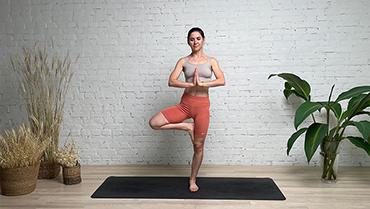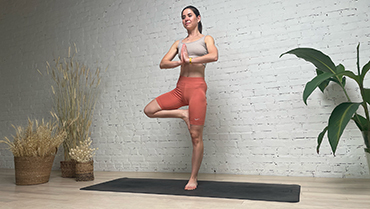Tree Pose - Vrksasana

Contents
Tree Pose or Vrksasana in Sanskrit (‘Vrksa’ means ‘Tree’ and ‘asana’ means ‘pose’) is a yoga posture that strengthens the legs, improves balance, and cultivates mindfulness. The very name suggests the body in the final pose should look like a tree. A tree stands tall, strong, and straight. Thus, while practicing Vrksasana focus on keeping your standing leg strong and stable, rooting down through your foot and engaging your thigh muscles. You can also experiment with different arm positions, such as reaching your arms out to the sides or bringing them down to your sides for more support. Remember to breathe deeply and stay present in the pose, allowing yourself to feel grounded and rooted like a tree.
Pose Detail
- By Type: Balancing Yoga Poses, Hip Opening Yoga Poses, Strengthening Yoga Poses, Yoga Poses For Seniors
- Difficulty: Beginners
- Body Position: Standing Yoga Poses
- By Benefit: Yoga Poses For Anxiety And Panic Attack, Yoga Poses For Stress Relief
Step-by-Step Instructions
Benefits and Contraindications
Improves neuromuscular coordination
Improves balance, endurance and alertness
Tones up the leg muscles and ligaments
Helps in bone development and proper alignment of the vertebral column
Helps relieve premenstrual symptoms like leg cramps and abdominal cramps
Relieves stress and anxiety
Arthritis and/or vertigo
Obesity
Knee or hip injury
Photo poses in different angles


Modifications and Props
Several props can be used to help modify or deepen the practice of Vrksasana (Tree Pose), including:
- Yoga block: If you have trouble balancing or can’t reach your foot to your thigh, you can place a block under your foot for support. This will help you maintain the proper alignment and feel more stable.
- Wall:
- Strap: If you have difficulty bringing your foot up to your thigh or keeping your arms lifted, you can use a strap to help. Loop the strap around the ball of your foot and hold onto the ends with your hands. This will give you more leverage to lift your foot higher and maintain the pose.
- Blanket: If you have sensitive knees, you can place a blanket under your standing foot for extra cushioning.
Stand with your back against a wall and place your foot on the wall at the level of your thigh. The wall will provide stability and support as you work on finding your balance.
Useful Tips
Keep the knee of your standing leg soft – do not lock the knee especially if you are hypermobile.
To help with your stability and balance:
- Spread through the toes and press the foot firmly into the floor but try not to clench your foot so that it can make small movements to help keep your balance.
- Engage the muscles of the leg, hips, glutes.
- Maintain an active core.
Frequently Asked Questions
To improve your balance in Tree Pose, focus on finding a steady gaze and engaging your core muscles. You can also practice with a chair or wall for support until you feel more comfortable on your own.
In Tree Pose, your weight should be evenly distributed between your standing foot and the foot that’s lifted. Your lifted foot should be pressing firmly into your standing leg, and your hips should be level. You can ask a yoga teacher to check your alignment or use a mirror to check it yourself.
If you have knee or ankle pain, you may need to modify the pose or avoid it altogether. Consult with a doctor or yoga teacher for guidance on modifications that can make the pose more accessible for you.
Tree Pose can be practiced during pregnancy with modifications to accommodate your changing body. However, it’s best to consult with a doctor or yoga teacher before beginning any new yoga practice during pregnancy.
Hold Tree Pose for 5-10 breaths, or as long as you feel comfortable. As you become more comfortable with the pose, you can gradually increase the length of time you hold it.
To deepen the stretch in Tree Pose, press your foot firmly into your thigh and draw your thigh and foot closer together. You can also reach your arms up overhead to increase the stretch in your side body and arms.
Variations
- Tree Pose Aerial
- Palm Tree Pose Variation Elbows
- Half Lotus Tree Pose
- Tree Pose Foot Chair
- Tree Pose Hand Wall
- Tree Pose On Block
- Tree Pose Side Bend
Top Preparatory Poses
- Mountain Pose
- Standing Forward Bend Pose
- Balancing Table Top Pose